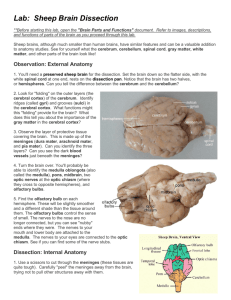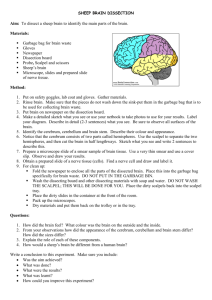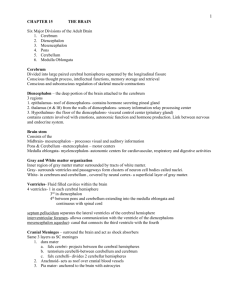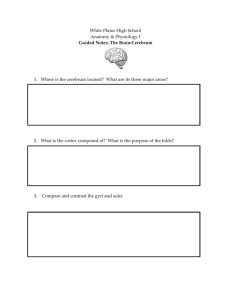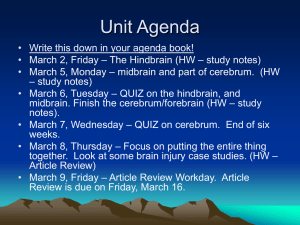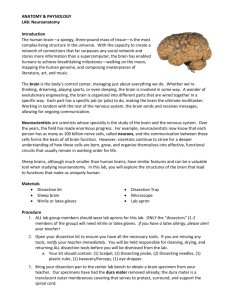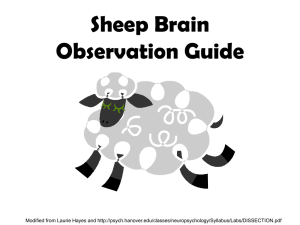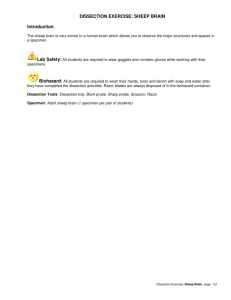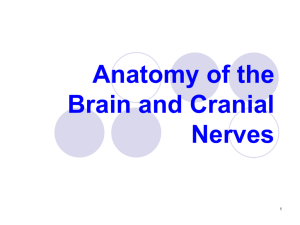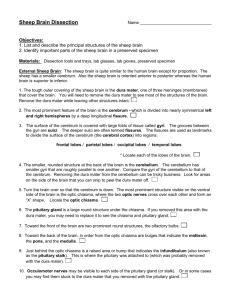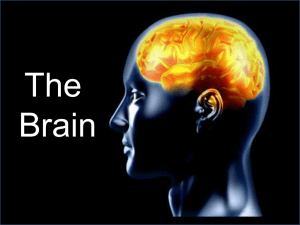Lab - Sheep Brain Dissection (word)
advertisement
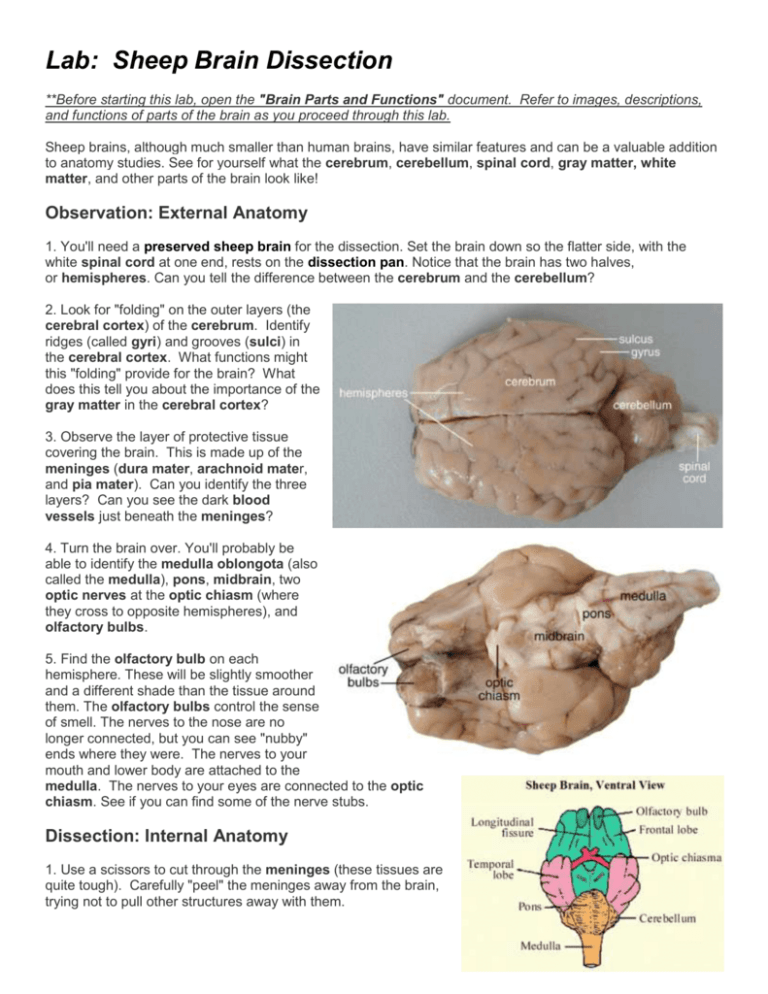
Lab: Sheep Brain Dissection **Before starting this lab, open the "Brain Parts and Functions" document. Refer to images, descriptions, and functions of parts of the brain as you proceed through this lab. Sheep brains, although much smaller than human brains, have similar features and can be a valuable addition to anatomy studies. See for yourself what the cerebrum, cerebellum, spinal cord, gray matter, white matter, and other parts of the brain look like! Observation: External Anatomy 1. You'll need a preserved sheep brain for the dissection. Set the brain down so the flatter side, with the white spinal cord at one end, rests on the dissection pan. Notice that the brain has two halves, or hemispheres. Can you tell the difference between the cerebrum and the cerebellum? 2. Look for "folding" on the outer layers (the cerebral cortex) of the cerebrum. Identify ridges (called gyri) and grooves (sulci) in the cerebral cortex. What functions might this "folding" provide for the brain? What does this tell you about the importance of the gray matter in the cerebral cortex? 3. Observe the layer of protective tissue covering the brain. This is made up of the meninges (dura mater, arachnoid mater, and pia mater). Can you identify the three layers? Can you see the dark blood vessels just beneath the meninges? 4. Turn the brain over. You'll probably be able to identify the medulla oblongota (also called the medulla), pons, midbrain, two optic nerves at the optic chiasm (where they cross to opposite hemispheres), and olfactory bulbs. 5. Find the olfactory bulb on each hemisphere. These will be slightly smoother and a different shade than the tissue around them. The olfactory bulbs control the sense of smell. The nerves to the nose are no longer connected, but you can see "nubby" ends where they were. The nerves to your mouth and lower body are attached to the medulla. The nerves to your eyes are connected to the optic chiasm. See if you can find some of the nerve stubs. Dissection: Internal Anatomy 1. Use a scissors to cut through the meninges (these tissues are quite tough). Carefully "peel" the meninges away from the brain, trying not to pull other structures away with them. 1 Lab: Sheep Brain Dissection 2. Place the brain with the curved top side of the cerebrum facing up. Use a scalpel to make a vertical section separating the two hemispheres. Slice through the brain along the center line, starting at the cerebrum and going down through the cerebellum, spinal cord, medulla, and pons. Separate the two halves (hemispheres) of the brain and lay them with the inside facing up. 3. Use the labeled picture and information below to identify the parts/regions of the brain as well as the hypothalamus and two Endocrine glands: the pineal gland and the pituitary gland (in many preserved specimens the pituitary gland is no longer present. It is not pictured, but try to locate the place where it attaches to the brain). The pituitary gland protrudes from the bottom of the hypothalamus (hint: "hypo" means below – the hypothalamus sits "below" the thalamus).Use your fingers or a teasing needle to gently probe the parts and see how they are connected to each other. What does the opening inside the corpus callosum lead to? How many different kinds of tissue can you see and feel? 4. Locate and identify these structures: The corpus callosum is a bundle of white fibers that connects the two hemispheres of the brain, providing coordination between the two. The medulla is located right under the cerebellum. Here, the nerves cross over so the left hemisphere controls the right side of the body and vice versa. This area of the brain controls the vital functions like heartbeat and respiration (breathing). The pons is next to the medulla. It serves as a bridge between the medulla and the upper brainstem, and it relays messages between the cerebrum and the cerebellum. The pituitary gland (part of the Endocrine System), which produces important hormones, is a sac-like area that attaches to the brain between the pons and the optic chiasm. This may or may not be present on your specimen. The pineal gland (part of the Endocrine System) produces hormones affecting modulation of wake/sleep patterns and seasonal fluctuations. Ventricles contain cerebrospinal fluid (CSF) The occipital lobe receives and interprets visual sensory messages The temporal lobe is involved in hearing and smell. You can find this by looking on the outside of one of the hemispheres. You will see a horizontal groove called the lateral fissure. The temporal lobe is the section of the cerebrum below this line. 2 Lab: Sheep Brain Dissection The frontal lobe also plays a part in smell, plus dealing with motor function The parietal lobe handles all the sensory info except for vision, hearing, and smell. The thalamus is a "relay station" for sensory information. It receives messages from the nerve axons and then transmits them to the appropriate parts of the brain. The diencephalon is the region made up of the thalamus, the hypothalamus, and the third ventricle. The pineal gland produces hormones affecting sleep/wake patterns and seasonal fluctuations. 5. Look closely at the inside of the cerebellum. You should see a branching "tree" of lighter tissue surrounded by darker tissue. The branches are white matter, which is made up of nerve axons. The darker tissue is gray matter, which is a collection of nerve cell bodies. You can see gray and white matter in the cerebrum, too, if you cut into a portion of it. The cerebellum serves as the "autopilot," controlling body movement and balance. 6. Make a transverse section through the brain (cut perpendicular to the vertical section you originally made to separate the two hemispheres of the brain. Look for the "folds" in the cerebral cortex. Identify the sulci (singular sulcus) and gyri (singular gyrus). How do these folds affect the total area of the cerebral cortex? Why is this important? Look for gray matter at the outer edges of the cerebral hemispheres (at the cerebral cortex). This contains neuron cell bodies. Look for white matter extending between the gray matter of the cerebral cortex and the corpus callosum, which is the white matter connecting the left and right hemispheres of the brain. This is the neuron axons. 7. Using a scalpel, do a "surface scrape" of the surface of the brain. Carefully scrape off layers of tissue. What do you observe? 8. If you have a microscope, slice off a very thin section of the cerebrum and put it on a slide, covering it with a drop of water and a coverslip. Look at it under 100X and 400X magnification. Follow the same procedure with a section of the cerebellum, then compare and contrast the two. Analysis Imagine you didn't know anything about how the brain works. By examining the sheep brain, what conclusions might you draw about how the brain works? What conclusions might you draw about brain function based upon brain structure? Psychosurgery 1. In the 1950's, brain researcher Roger Sperry and his colleagues studied patients whose brain hemispheres had been functionally separated. What part of the brain was severed or not functioning in order for the test subjects to have independently-functioning cerebral hemispheres? 2. Phineas Gage 3. Frontal lobotomy 4. Electrical or mechanical stimulation of the Motor Cortex, Somatosensory Cortex, or other brain regions. 3 Lab: Sheep Brain Dissection Label the Parts of a Sheep Brain to test your knowledge of sheep brain anatomy. 4
